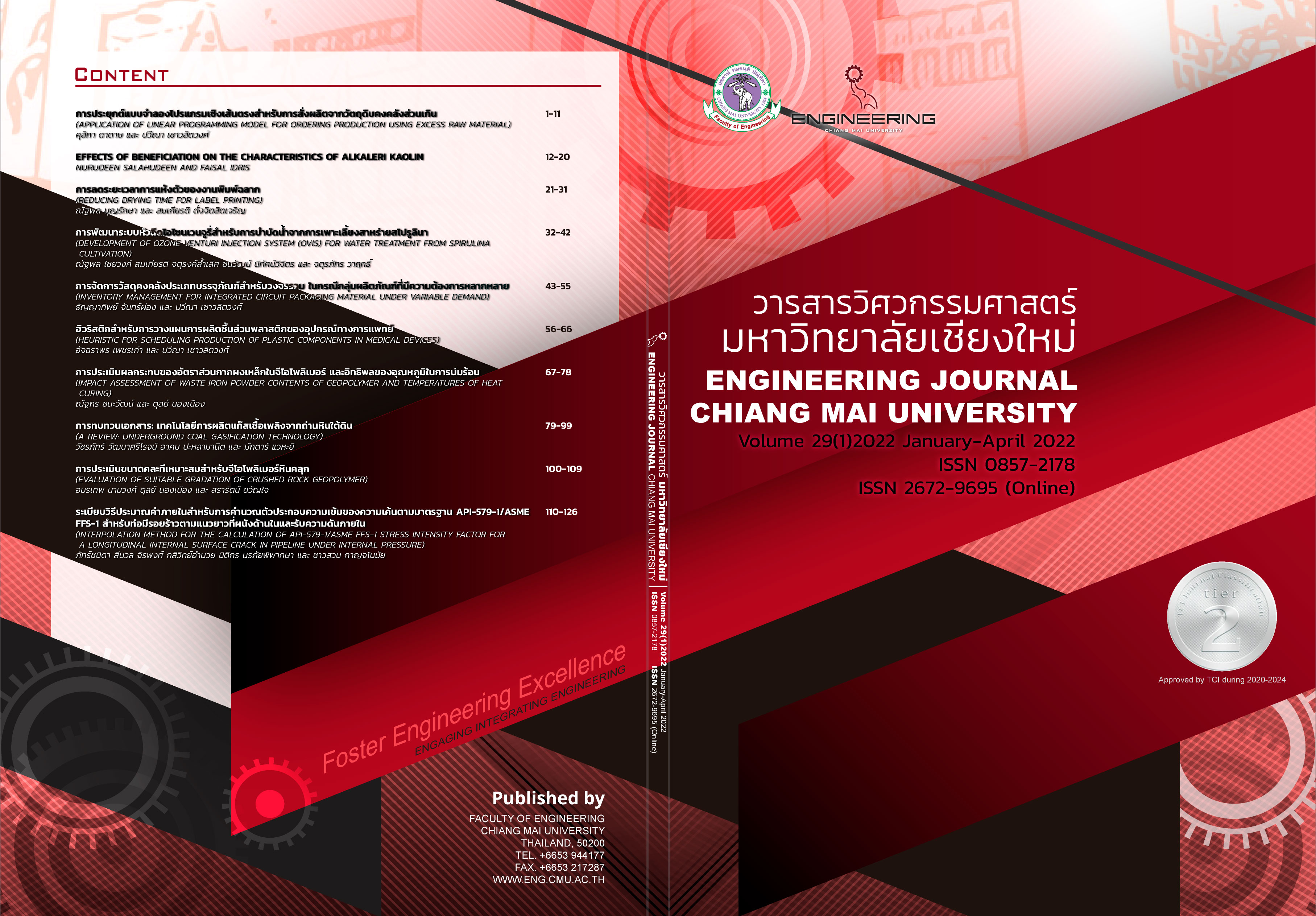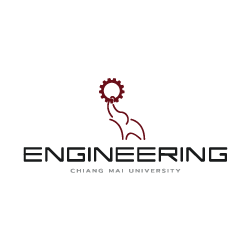Development of Ozone Venturi Injection System (Ovis) for Water Treatment from Spirulina Cultivation
Keywords:
Ozone venturi injection system, Faced Central Composite (FCC), Water treatmentAbstract
This paper proposes an appropriate ordering policy to improve the efficiency of inventory management for the packaging group of 24 items in a semiconductor factory, this is to reduce total cost while maintaining service level at 95%. The total cost is comprised of ordering cost and inventory holding cost. This study was conducted as follows. Firstly, all relevant data (e.g., inventory data, ordering conditions, and constraints) is reviewed. Then, the demand is divided into 2 patterns: 1. Smooth demand 2. Erratic demand. So, the grouped demand will be defined by the inventory policies. The concept of policy design is to be replenished at any time because the inventory is continuously reviewed. Thus, the Re-Order point (ROP) policy and (s, S) policy are proposed for Smooth demand pattern and Erratic demand pattern consecutively.
The proposed policies are tested with demand data from 2019 and 2020. The results show a total reduction from 111,832 USD to 46,288 USD in 2019 or decreased by 58.61%, and from 132,886 USD to 51,404 in 2020 or decreased by 64.29%. While the policy is still able to maintain the service level as Fill Rate in 2019 and 2020, the average per year is 95.13% and 95.36% respectively. Additionally, the sensitivity analysis result shows that the proposed policy is robust to changes in demand patterns. There are only about 13% changes in total cost compared to 50% changes in average demand or the worst-case scenario for demand changes.
References
C. O’ Donnell, B. K. Tiwari, P. J. Cullen, and R. G. Rice, Ozone in Food Processing. UK: Wiley-Blackwell, 2012.
ปฏิวัติ บุญมา, ชาญณรงค์ หนูอินทร์, และ ประมุข อุณหเลขกะ, “การประยุกต์ใช้ไมโครบับเบิ้ลโอโซนร่วมกับระบบเติมอากาศแบบเวนจูรี่ในการบำบัดน้ำในคลองพระพิมลราชา ตลาดน้ำไทรน้อย อำเภอไทรน้อย จังหวัดนนทบุรี,” วารสารวิชาการ มทร.สุวรรณภูมิ, ปีที่ 6, ฉบับที่ 1, หน้า 45-54, 2561.
ภัทรพล กล่ำเสือ, “การบำบัดสีและกลิ่นของน้ำเสียจากห้องพ่นสีด้วยโอโซน,” วิทยานิพนธ์ วศ.บ., มหาวิทยาลัย
ธรรมศาสตร์, ปทุมธานี, 2560.
สมเกียรติ จตุรงค์ล้ำเลิศ, ชนวัฒน์ นิทัศน์วิจิตร, จตุรภัทร วาฤทธิ์, และ จงกล พรมยะ, “การเสริมอัตราการถ่ายเทมวลของก๊าซคาร์บอนไดออกไซด์ในชุดคาร์บอเนเตอร์สำหรับการเพาะเลี้ยงสาหร่ายสไปรูลินา.” ในการประชุมวิชาการ การถ่ายเทพลังงานความร้อนและมวล ครั้งที่ 18, 2562, หน้า 53-59.
สุพิชฌาย์ วิจารณรงค์, “ผลของโอโซนต่อประสิทธิภาพการขจัดสี,” สารนิพนธ์ วศ.บ., มหาวิทยาลัยเกษตรศาสตร์, กรุงเทพฯ, 2550.
อานอบ คันฑะชา, “การศึกษาการบำบัดน้ำเสียจากคลองสำโรงโดยโอโซน,” สงขลา: มหาวิทยาลัยทักษิณ, 2545.
A. A. Gonçalves and C. Pereira Kechinski, “Ozone technology in the food industry.” In “Food Engineering.” B. C. Siegler, Eds., New York: Nova Science Publisher, 2011. pp. 85–146.
B. A. Schunacher, “Methods for the Determination of Total Organic Carbon (TOC) In Soils and Sediments,” Environmental Protection Agency, Washington, DC, 2002.
E. F. Karamah, S. Bismo, L. Annasari, and W. W. Purwanto, “Mass Transfer Study On Micro-Bubbles Ozonation In A Bubble Column,” International Journal of Chemical Engineering Research, vol. 2, no. 2, pp. 243–252, 2010.
H. Ikeura, F. Kobayashi, and M. Tamaki, “Removal Of Residual Pesticides In Vegetables Using Ozone Microbubbles,” Journal of Hazardous Material, vol. 186, no. 1, pp. 956–959, 2011.
H. Hadiyanto, M. Christwardana, D. I. Pratiwi, S. Silviana, M. Syarifudin, and A. Khoironi, “Rubber wastewater treatment using UV, ozone, and UV/ozone and its effluent potency for microalgae Spirulina platensis cultivation medium,” Cogent Engineering, vol. 186, pp. 1-11. 2019.
M. C. Galdeano, A. E. Wilhelm, I. B. Goulart, R. V. Tonon, O. Freitas-Silva, R. Germani, and D. W. H. Chávez, “Effect of water temperature and pH on the concentration and time of ozone saturation,” Brazilian Journal of Food Technology, vol. 21, pp. 1-7, 2018.
N. S. Zainuddin, F. P. Chee, J. H. W. Chang, C. F. Pien, and J. Dayou, “Development and Operational Implementation of a Novel Method for Production of Ozonated Water,” Transactions on Science and Technology, vol.4, no. 3, pp. 218-223, 2017.
L. S. Clesceri, A. E. Greenberg, and A. D. Eaton, Standard Methods for the Examination of water and wastewater. 20th ed. APHA American Public Health Association, 1998.
พรรณธิพา ไชยมงคล, ธัญศิภรณ จันทรหอม, และ สุรพงษ วัฒนะจีระ, “การสำรวจลักษณะสารอินทรีย์ละลายน้ำของ
น้ำในกระบวนการผลิตน้ำประปาอ่างแก้ว มหาวิทยาลัยเชียงใหม่,” ในการประชุมวิชาการทางวิศวกรรมศาสตร์มหาวิทยาลัยสงขลานครินทร์ ครั้งที่ 6, 2551, หน้า 14-19.
Downloads
Published
Issue
Section
License
ลิขสิทธิ์ของบทความที่ตีพิมพ์ในวารสารฉบับนี้จะยังเป็นของผู้แต่งและยินยอมให้สิทธิ์เผยแพร่กับทางวารสาร
การเผยแพร่ในระบบวารสารแบบเปิดนี้ บทความจะสามารถนำไปใช้ได้ฟรีในการศึกษา และในทางที่ไม่เกี่ยวกับการค้า




